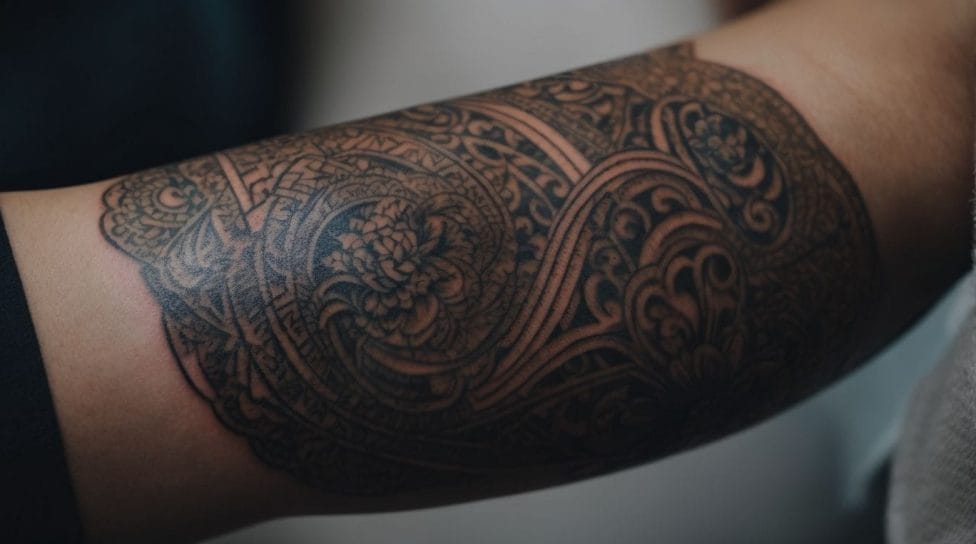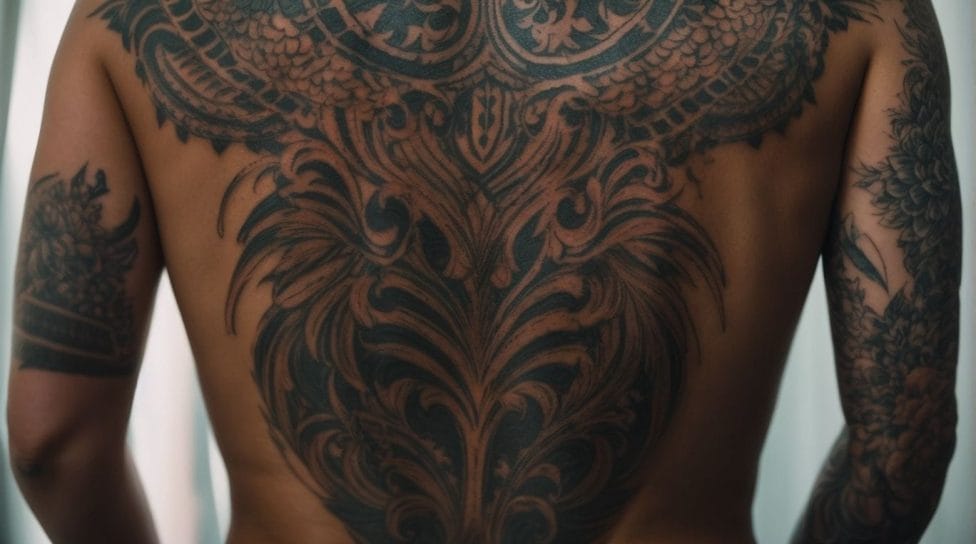Getting a tattoo involves some level of discomfort and pain, but the location of the tattoo can greatly affect the intensity of the pain. Understanding the factors influencing tattoo pain can help you choose the least painful areas for your tattoo. Factors such as tattoo placement, skin sensitivity, and the size and complexity of the design all play a role in how much a tattoo will hurt.
When it comes to the least painful tattoo areas, there are several options to consider. The upper arm, Thigh, calf, outer shoulder, and forearm are known to be relatively less painful areas for getting tattooed. These areas have thicker skin and a higher amount of muscle, which can help cushion the sensation of the tattoo needle.
On the other hand, certain tattoo areas tend to be more painful and are best to avoid if you want to minimize pain. The ribcage, spine, sternum, ankle, and behind the ear are areas where the skin is thinner and closer to the bone, making tattooing more uncomfortable.
To manage tattoo pain, there are some expert tips you can follow. One crucial step is to choose the right tattoo artist who has experience and a gentle hand. Taking breaks during the tattoo session can also help alleviate discomfort. You can consider using numbing creams or local anesthesia for larger tattoos. Deep breathing and relaxation techniques can help you stay calm and endure the pain during the tattooing process.
By understanding these factors and following expert tips, you can make an informed decision about the least painful tattoo areas and successfully manage any discomfort with getting a tattoo.
Key takeaways:
- Tattoo pain varies based on placement: Areas like the upper arm, Thigh, calf, outer shoulder, and forearm are generally less painful for tattoos due to more flesh and muscle.
- Avoid more painful areas for tattoos: The ribcage, spine, sternum, ankle, and behind the ear are areas to avoid if you want to minimize tattoo pain.
- Manage tattoo pain with expert tips: Choosing the right tattoo artist, taking breaks during the session, using numbing creams or local anesthesia, and practicing relaxation techniques can help manage tattoo pain.
Factors Affecting Tattoo Pain

Photo Credits: Tattooineplanet.Com by Alan Gonzalez
Tattoo pain can vary depending on a few key factors. Understanding these factors can help you decide where to get your next ink. From tattoo placement to skin sensitivity and design complexity, each sub-section will explore how these factors play a role in determining the pain level you may experience. So, whether you’re a first-time tattoo enthusiast or a seasoned pro looking for a new spot, let’s dive into the factors that affect tattoo pain and find out where tattoos hurt the least.
Tattoo Placement
Regarding tattoo placement, the right choice is crucial for minimizing pain and maximizing the overall tattooing experience. Take into account the following factors to determine the optimal location:
- Opt for areas with thicker skin and ample flesh, such as the upper arm or Thigh, as these can result in less pain during the tattoo process.
- Avoid highly sensitive areas like the ribcage, spine, or sternum, as these tend to be more painful.
- Remember that behind the ear and the ankle can be uncomfortable due to the proximity of bones to the skin’s surface.
- It’s always a good idea to consult with your tattoo artist, as they can offer valuable insights and advice.
Pro-tip: Consider choosing a placement with natural muscle padding, as this can help minimize pain during the tattooing process.
Skin Sensitivity
People with sensitive skin should take extra precautions when getting a tattoo. Here are some considerations to keep in mind:
- Please consult a professional tattoo artist. They can assess your skin sensitivity and recommend appropriate techniques or locations for your tattoo.
- Avoid areas with thin skin: Sensitive areas like the ribs, spine, and sternum tend to be more painful for individuals with sensitive skin.
- Opt for areas with thicker skin: The upper arms, thighs, and calves generally have thicker skin and may be less painful for those with sensitive skin.
- Consider a smaller design: Larger and more intricate designs can cause more discomfort, so choosing a smaller tattoo may be more comfortable for those with sensitive skin.
- Take care of your skin: Prioritize skincare to keep your skin in the best possible condition before getting a tattoo, as healthy skin is less likely to react adversely.
People with skin sensitivity should take extra precautions when getting a tattoo. Here are some considerations to keep in mind:
- Please consult a professional tattoo artist. They can assess your skin sensitivity and recommend appropriate techniques or locations for your tattoo.
- Avoid areas with thin skin: Sensitive areas like the ribs, spine, and sternum tend to be more painful for individuals with skin sensitivity.
- Opt for areas with thicker skin: The upper arms, thighs, and calves generally have thicker skin and may be less painful for those with skin sensitivity.
- Consider a smaller design: Larger and more intricate designs can cause more discomfort, so choosing a smaller tattoo may be more comfortable for those with skin sensitivity.
- Take care of your skin: Prioritize skincare to keep your skin in the best possible condition before getting a tattoo, as healthy skin is less likely to react adversely.
Tattoo Size and Design Complexity
When getting a tattoo, the size and design complexity are important factors that can impact the level of pain experienced during the process.
- Small and simple designs: Tattoos that are small in size and have simple designs tend to be less painful, as they require less time and precision to complete.
- Large and intricate designs: Larger tattoos with intricate designs can be more painful, requiring more time, multiple sessions, and finer details.
- Detailed areas: Tattooing on areas with many details, such as the ribs or inner arm, can be more painful due to the sensitivity and proximity to bones or nerves.
- Bold and solid areas: On the other hand, tattoos done on areas with more flesh and muscle, like the Thigh or calf, maybe less painful due to the cushioning.
- Personal pain tolerance: Everyone’s pain tolerance is different, so what may be painful for one person may not be as uncomfortable for another.
When considering the tattoo size and design complexity of your tattoo, it’s important to choose something that aligns with both your desired outcome and pain tolerance.
Least Painful Tattoo Areas

Photo Credits: Tattooineplanet.Com by Terry Green
Discover the secret to getting inked with the least amount of pain! In this section, we’ll explore various areas of the body known to be the least painful for getting tattoos. From the upper arm to the outer shoulder, Thigh to calf, and forearm, we’ll uncover the most comfortable spots for your next tattoo experience. Prepare to be amazed as we reveal which areas can make your tattoo journey a breeze.
Upper Arm
When considering getting a tattoo on your upper arm, there are a few things to keep in mind for a more comfortable experience:
- Choose a part of the upper arm with more muscle and fat, as it tends to be less sensitive.
- Avoid areas near bones or joints, as these can be more painful.
- Consider the size and design of the tattoo, as more complex designs or larger tattoos may cause more discomfort.
- Ensure proper aftercare to minimize any pain or discomfort during the healing process.
By keeping these factors in mind, you can increase the likelihood of a less painful tattoo experience on your upper arm.
Thigh
Selecting the Thigh as the placement for your tattoo can have several advantages.
- Less Pain: The Thigh is considered one of the least painful areas to get a tattoo due to the abundance of muscle and fatty tissue.
- Bigger canvas: The Thigh provides a spacious area for larger or more intricate designs, allowing for more creativity and detail.
- Easy concealment: If you prefer to keep your tattoo more discreet, the Thigh offers the option to cover it easily with clothing.
- Minimal fading: Tattoos on the Thigh tend to experience less fading over time compared to areas frequently exposed to the sun.
- Versatility: The Thigh can be easily incorporated into leg sleeve designs or complement other tattoos on the leg.
Selecting the Thigh as the Placement for Your Tattoo can have several advantages.
- Less Pain: The Thigh is considered one of the least painful areas to get a tattoo due to the abundance of muscle and fatty tissue.
- Bigger Canvas: The Thigh provides a spacious area for larger or more intricate designs, allowing for more creativity and detail.
- Easy Concealment: If you prefer to keep your tattoo more discreet, the Thigh offers the option to cover it easily with clothing.
- Minimal Fading: Tattoos on the Thigh tend to experience less fading over time compared to areas frequently exposed to the sun.
- Versatility: The Thigh can be easily incorporated into leg sleeve designs or complement other tattoos on the leg.
Calf
The calf is an extremely popular area for getting tattoos because of its large, flat surface and minimal sensitivity to pain. Many individuals opt to showcase their favorite artwork or meaningful designs on this specific region of their body. The calf offers abundant space for intricate and larger-scale tattoos, making it an incredibly versatile canvas. When considering a calf tattoo, it is important to carefully contemplate the placement as it can impact visibility and future design opportunities. It is crucial to select a skilled tattoo artist who can skillfully bring your vision to life with precision. Additionally, providing proper aftercare is essential for optimal healing and to ensure the long-lasting quality of your tattoo.
Outer Shoulder
The visibility and versatility of the outer shoulder make it a popular tattoo placement. This area is a canvas for small and large designs, offering ample space. Compared to more sensitive areas like the ribcage or spine, the outer shoulder is less painful. This is because it has a thicker layer of muscle and padding, which effectively cushions the impact of the tattoo needle. If you’re seeking a tattoo placement that combines visibility with a manageable pain level, the outer shoulder is an excellent choice.
Forearm
The forearm is a popular location for getting a tattoo due to its visibility and flat surface. When considering getting a tattoo on the forearm, there are several factors to consider.
Firstly, the forearm is generally known to have a lower pain level than other areas. This is because it has ample flesh and muscle tissue, which helps in reducing the discomfort during the tattooing process.
Another advantage of choosing the forearm as the placement for your tattoo is the wide and flat canvas it provides. This allows for various design options, whether you prefer a sleeve tattoo or smaller individual ones.
Additionally, the forearm is easily accessible for aftercare purposes. During the healing process, it is important to clean and moisturize the tattoo regularly. The forearm’s accessibility makes it convenient to take care of the tattoo and ensure proper healing.
It’s interesting to note that the forearm is among the top five most common tattoo placements. This shows its popularity among tattoo enthusiasts.
So, if you are considering getting a tattoo, the forearm is a great option to explore due to its lower pain level, design versatility, easy aftercare, and widespread popularity.
Tattoo Areas to Avoid for Minimizing Pain

Photo Credits: Tattooineplanet.Com by Adam Anderson
Are you looking to get a tattoo but want to minimize the pain? Let’s dive into the tattoo areas to avoid when it comes to minimizing discomfort. From the sensitive ribcage to the delicate spine, the tender sternum to the tricky ankle, and even behind the ear, we’ll guide you on which areas may cause more pain so you can make an informed decision for your next ink session. Let’s explore the pain factor and find the perfect spot for your new tattoo!
Ribcage
The ribcage, one of the most sensitive areas for getting a tattoo, can be quite painful due to the proximity of bones and thin skin. The level of pain experienced varies depending on an individual’s pain tolerance, but it is generally considered a discomforting and sharp experience. It is crucial to prepare both mentally and physically before deciding to get a tattoo in this particular area. Some individuals have shared their stories of getting tattoos on their ribcages, describing the whole experience as intense yet manageable by incorporating deep breathing and relaxation techniques.
Spine
| Spine |
| Factors Affecting Tattoo Pain |
| Tattoo Placement |
| Skin Sensitivity |
| Tattoo Size and Design Complexity |
| Least Painful Tattoo Areas |
| Upper Arm |
| Thigh |
| Calf |
| Outer Shoulder |
| Forearm |
| Tattoo Areas to Avoid for Minimizing Pain |
| Ribcage |
| Spine |
| Sternum |
| Ankle |
| Behind the Ear |
| Expert Tips for Managing Tattoo Pain |
| Choose the Right Tattoo Artist |
| Take Breaks During the Tattoo Session |
| Use Numbing Creams or Local Anesthesia |
| Practice Deep Breathing and Relaxation Techniques |
Pro-tip: Discuss pain management strategies with your tattoo artist before getting a tattoo on sensitive areas like the spine.
Sternum
The sternum is an area to avoid to minimize tattoo pain. The thin skin and proximity to bone make the sternum a sensitive and potentially uncomfortable spot. Choosing other areas like the upper arm, Thigh, or forearm can provide a less painful experience. When getting a tattoo on the sternum, it’s important to communicate with your tattoo artist and manage pain with techniques such as numbing creams or local anesthesia. Fun fact: The sternum, also known as the breastbone, is located in the center of the chest and connects the ribcage.
Ankle
The ankle, a popular location for tattoos, can be a painful area due to its proximity to the bone and lack of fatty tissue. However, individual pain tolerance may vary. It is crucial to select a skilled tattoo artist who can minimize discomfort by employing proper techniques and tools. Taking breaks during the tattoo session can help manage pain and provide temporary relief. Additionally, numbing creams or local anesthesia may numb the ankle area and reduce discomfort. Despite the potential pain, many individuals still opt for ankle tattoos due to their aesthetic appeal and symbolism.
Behind the Ear
Getting a tattoo behind the ear, also known as “ear tattoos,” can be a unique and stylish choice, showcasing your style and creativity. However, it’s important to consider the pain associated with this placement. Here are some key aspects to know about getting a tattoo behind the ear:
- High Sensitivity: The skin behind the ear is naturally thin and delicate, making it a more sensitive area to tattoo.
- Pain Level: The Pain experienced during tattooing behind the ear can vary from person to person. Some individuals may describe it as a moderate level of discomfort.
- Tattoo Size: Generally, smaller designs tend to be less painful when placed behind the ear than larger ones.
- Healing Process: Due to the area’s proximity to the hairline, proper aftercare is crucial to prevent infections or irritations.
Pro-tip: To enhance your comfort during the tattooing process, consider discussing pain management options or utilizing numbing creams with your experienced tattoo artist. By doing so, you can make the entire experience more pleasant.
Expert Tips for Managing Tattoo Pain

Photo Credits: Tattooineplanet.Com by Walter King
Are you looking to get inked but worried about the pain factor? We’ve got you covered! In this section, we’ll share expert tips on managing tattoo pain like a pro. Discover how choosing the right tattoo artist, taking strategic breaks during the session, utilizing numbing creams or local anesthesia, and practicing relaxation techniques can help minimize discomfort. Say goodbye to tattoo pain woes, and hello to a more enjoyable tattoo experience!
Choose the Right Tattoo Artist
Choosing the right tattoo artist is essential for a successful and satisfying tattoo experience. Here are some factors to consider in your search:
- Experience: When choosing a tattoo artist, it’s crucial to find someone with a solid portfolio and years of experience in the style you desire.
- Artistic Style: It’s important to locate an artist whose artistic style aligns with your vision and aesthetic preferences.
- Cleanliness and Safety: Prioritize an artist who follows proper hygiene practices and works in a clean and sterile environment to ensure your safety.
- Communication: Select an artist who actively listens to your ideas, provides valuable feedback, and communicates effectively throughout the tattooing process.
- Reviews and Recommendations: To assess an artist’s reputation, take the time to read reviews and seek recommendations from friends or fellow tattoo enthusiasts.
Take Breaks During the Tattoo Session
Taking breaks during a tattoo session is crucial to manage pain and discomfort. Here are some reasons why it’s important to take breaks during the tattoo session:
- Relieve muscle tension: Sitting in one position for an extended period can cause muscle strain. Taking breaks allows you to stretch and alleviate tension.
- Reduce pain sensitivity: Continuous tattooing can lead to increased pain sensitivity. By taking short breaks, you give your body a chance to recover, making the process more bearable.
- Mental and emotional respite: Tattoo sessions can be physically and mentally draining. Taking breaks gives you time to relax, gather, and mentally prepare for the next phase.
Remember, communication with your tattoo artist is crucial during breaks to ensure you’re both on the same page.
Use Numbing Creams or Local Anesthesia
- When considering tattoo pain relief, it is advisable to use numbing creams or local anesthesia. These methods can help alleviate the discomfort.
- Before using the numbing cream, it is important to consult either your tattoo artist or a medical professional. They can guide you in choosing the appropriate cream or anesthesia.
- Follow the instructions provided on the packaging of the numbing cream. Make sure the area where the tattoo will be applied is clean and dry.
- To enhance the effectiveness of the numbing cream, cover it with a plastic wrap. Allow the cream to absorb into the skin for the recommended duration.
- For individuals opting for local anesthesia, it is essential to consult with a medical professional who can administer it safely.
- During your tattoo session, maintain open communication with your artist. If you experience any discomfort, inform them promptly. This will allow adjustments to the numbing process or tattooing technique.
Remember, always prioritize the guidance and instructions professionals provide to ensure the safe and effective use of numbing creams or local anesthesia.
Practice Deep Breathing and Relaxation Techniques
Practice Deep Breathing and Relaxation Techniques can be incredibly helpful in managing tattoo pain during the tattooing process. To effectively use these techniques, follow these steps:
- Before the session, take the time to learn various deep breathing exercises that can aid in calming your nerves.
- While getting the tattoo, make a conscious effort to focus on your breath and attempt to take slow, deep breaths.
- Utilize visualization techniques to imagine yourself in a tranquil and soothing environment.
- Engage in progressive muscle relaxation by deliberately tensing and then releasing different groups of muscles in your body.
- Involve yourself in mindfulness meditation to remain present and diminish anxiety.
Allow me to share a true story about Sarah, who was undergoing her first tattoo session. Throughout the process, Sarah successfully employed Practice Deep Breathing and Relaxation Techniques. By staying dedicated to her breath and picturing herself on a serene beach, she effectively managed the pain and experienced a heightened sense of relaxation.
Some Facts About Where Do Tattoos Hurt the Least?:
- ✅ The forearms are considered one of the least painful areas to get a tattoo. (Source: Business Insider)
- ✅ The stomach is another area often known for being less painful when getting a tattoo. (Source: Business Insider)
- ✅ Many individuals have reported that the outer thighs are less painful for tattooing. (Source: Business Insider)
- ✅ pain during tattooing can vary between individuals based on age, sex, and pain tolerance. (Source: Healthline)
- ✅ While there is no scientific evidence, anecdotal information from the tattoo industry suggests that areas with more flesh and muscle tend to be less painful for tattoos. (Source: Healthline)


